Fetal Monitoring Market Research, 2032
The global fetal monitoring market size was valued at $3.4 billion in 2022, and is projected to reach $6.2 billion by 2032, growing at a CAGR of 6.2% from 2023 to 2032. Fetal monitoring is a diagnostic tool used to monitor movement and heart rate of the fetus and maternal contractions and uterine contractions during labor. It mainly monitors well-being of fetus and the progress of labor. In medical terms, it is referred to as a medical method to check the health of an unborn baby to ensure a safe birth.
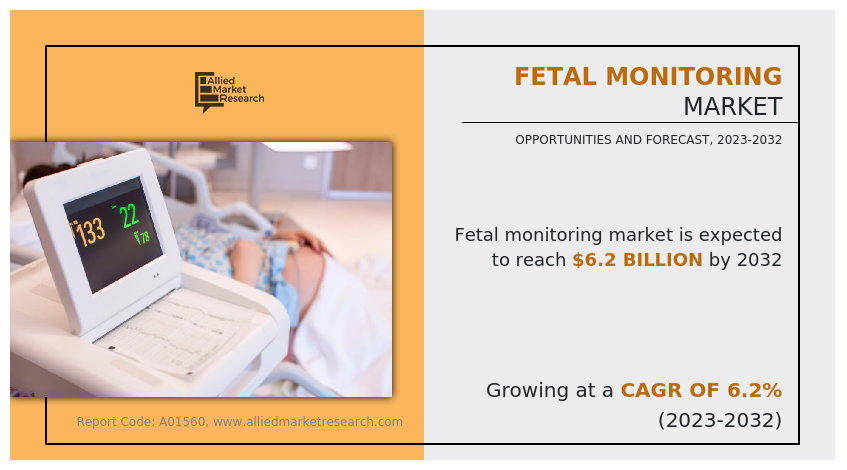
Market Dynamics
The increase in incidence of pregnancy-related complications, such as gestational diabetes, hypertension, and preterm labor, has necessitated the use of fetal monitoring to closely monitor the well-being of the fetus and detect any potential issues early on. Fetal monitoring allows for timely interventions and appropriate management of complicated pregnancies. New fetal monitoring solutions such as software based and telemetry solutions are widely used in developing and underdeveloped countries. In the future, healthcare expenditure is anticipated to increase in India and China in line with economic growth in these nations which support the fetal monitoring market growth.
Technological advancements in fetal monitoring devices, such as ultrasound system, and portable fetal devices has improved the accuracy and efficiency of monitoring which contributes toward the market growth. Advanced features such as real-time data analysis, wireless connectivity, and portability have made monitoring more convenient for healthcare providers and expectant mothers. Thus, the technological advancements with cost-effective devices in these nations offer lucrative fetal monitoring market opportunity.
In addition, government initiatives and policies aimed at improving maternal and child health have promoted the use of fetal monitoring in prenatal care. For instance, according to the U.S. Department of Health and Human Services, the Maternal, Infant, and Child Health Workgroup under Healthy People 2030 aims to reduce the rates of disease and death among women, infants, and children. It focuses on reducing pregnancy-related complications, increasing access to high-quality health care, promoting healthy behaviors, and addressing disparities. Such initiatives by government and non-government organizations drive the fetal monitoring industry growth.
Furthermore, a surge in demand for fetal monitoring during pregnancy is anticipated to drive the market growth. Technological advancements and surge in preterm births and birth rates are expected to provide the fetal monitoring opportunity in the future. In addition, growth in premature delivery rate, hemorrhage rate, and surge in need for fetal monitoring devices enhance the global market. Moreover, the emergence of portable and wireless products and technologies as well as untapped emerging economies provide lucrative growth opportunities globally. The demand for fetal monitoring is not only limited to developed countries but is also being witnessed in the developing countries, such as China, Brazil, and India, which fuel the growth of the market. Factors such as rise in adoption of advanced fetal monitoring devices and increase in awareness toward prenatal care further drive the growth of the market.
Advanced fetal monitoring devices may be costly to acquire and maintain. The initial investment in purchasing the equipment, along with ongoing maintenance and calibration expenses, can be a significant financial burden for healthcare facilities, especially in resource-limited settings. The high cost of devices may deter some healthcare providers from adopting or upgrading their fetal monitoring technology. Thus, the high cost of fetal monitoring devices hampers the growth of the market.
During a recession, governments, research institutions, and pharmaceutical companies may face budget constraints and reduced funding. This lead to decrease in research budgets, affecting the demand for fetal monitoring devices. Research projects could be delayed or canceled, resulting in decline in the number of studies requiring animal models. During an economic downturn, regulatory agencies might face pressure to reduce costs and streamline processes. Thus, 2023 negatively impacted the market growth owing to the budget cuts and emergence of alternative technology.
Segmental Overview
The fetal monitoring market analysis is segmented into product, method, portability, application, end user, and region. By product, the market is categorized into ultrasound, electronic fetal monitoring (EFM), accessories and consumables. The ultrasound segment is further categorized into 2D ultrasound, 3D and 4D ultrasound, and doppler imaging. The electron fetal monitoring (EFM) segment is further divided into external EFM and internal EFM. On the basis of method, the market is segregated into invasive and non-invasive. As per portability, the market is classified into portable and non-portable. By application, it is divided into intrapartum fetal monitoring and antepartum fetal monitoring. According to end user, the market is categorized into hospitals and maternity hospitals, clinics, and others. Region wise, the market is analyzed across North America, Europe, Asia-Pacific, and LAMEA.
By Product
The ultrasound segment dominated the global fetal monitoring market share in 2022 and is expected to remain dominant throughout the forecast period, owing to high adoption of the ultrasound devices to monitor fetal health during pregnancy and labor. In addition, these devices offer non-invasive and safe monitoring, allowing healthcare professionals to detect any potential abnormalities or complications early on, leading to timely interventions and improved pregnancy outcomes which further support the segment growth. However, the electronic fetal monitoring (EFM) segment is expected to register the highest CAGR during the forecast period. This is attributed to the advancements in technology have led to the development of advanced EFM systems, including wireless and portable devices, which enhance the convenience and flexibility of monitoring for both healthcare providers and expectant mothers.
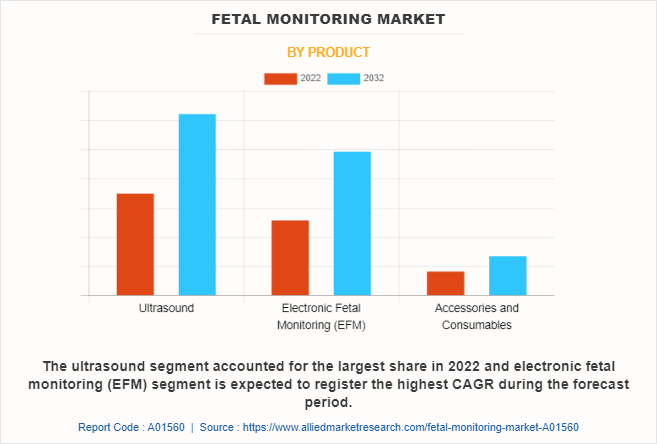
By Method
The non-invasive segment dominated the global fetal monitoring market share in 2022 and is anticipated to continue this trend during the forecast period. This is attributed to the increase in preference for non-invasive fetal monitoring methods among healthcare providers and expectant mothers. In addition, non-invasive fetal monitoring techniques, such as ultrasound devices and fetal electrocardiography (FECG), have gained significant popularity due to their high safety, ease of use, and ability to provide valuable information about the fetus without any direct penetration or risk to the mother and baby which is expected to drive the segment growth.
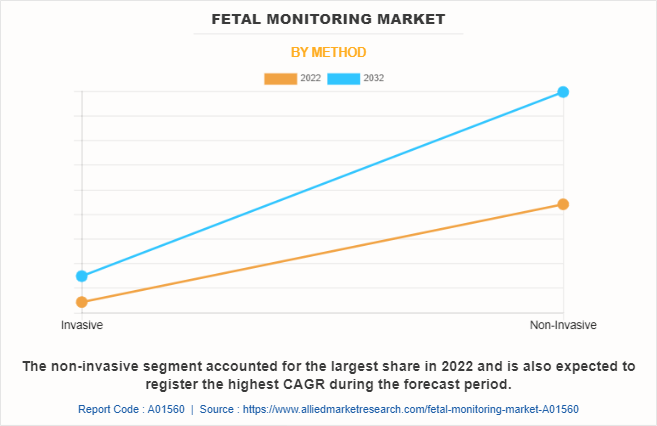
By Portability
The portable segment held the largest fetal monitoring market share in 2022 and is expected to remain dominant throughout the forecast period, owing to the advancements in ultrasound technology which led to the development of highly sophisticated and compact portable fetal monitoring devices. They offer high-resolution imaging, real-time data analysis, and wireless connectivity, providing healthcare professionals with accurate and instant information about fetal well-being. However, the portable segment is expected to register the highest CAGR during the forecast period. This is attributed to increase in need for mobility, convenience, and remote patient monitoring and growing emphasis on telemedicine and remote patient monitoring led to increase in demand for portable devices.
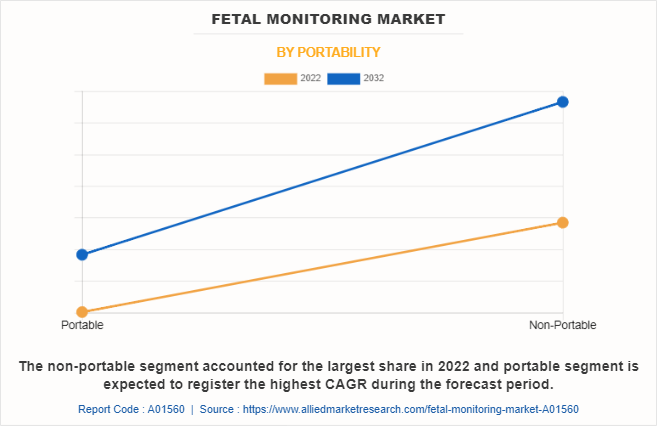
By Application
The antepartum fetal monitoring segment held the largest market share in 2022 and is expected to remain dominant throughout the forecast period, owing to rise in awareness among mothers and healthcare providers about the importance of monitoring fetal health during pregnancy. Antepartum fetal monitoring allows healthcare professionals to assess the well-being of the fetus before labor and delivery, enabling early detection of any potential issues or complications. This early intervention can lead to better management of high-risk pregnancies and improved outcomes for both the mother and the baby.
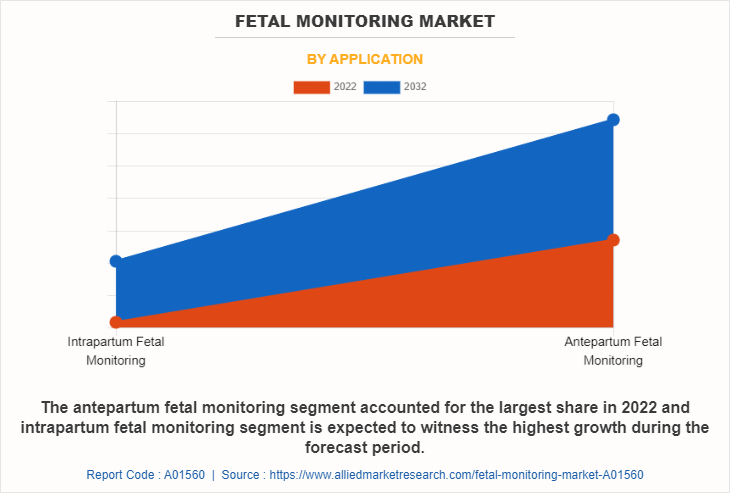
However, the intrapartum fetal monitoring segment is expected to register the highest CAGR during the forecast period owing to rise in technological advancements in fetal monitoring devices, increased focus on perinatal care, and the rising prevalence of high-risk pregnancies.
By End User
The hospitals and maternity hospitals segment held the largest market share in 2022 and is expected to remain dominant throughout the forecast period, as hospitals are well-equipped to handle high-risk pregnancies that require more intensive fetal monitoring. In addition, they have access to specialized equipment and facilities to manage complicated cases effectively, giving them an advantage over other healthcare settings in handling challenging situations.
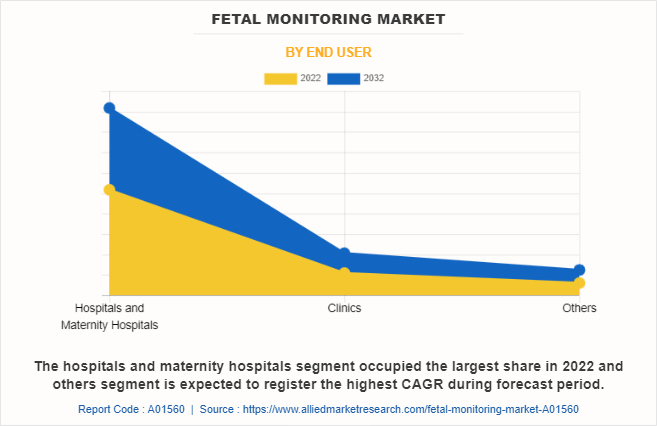
However, the others segment is expected to register the highest CAGR during the forecast period owing to a growing trend toward patient-centric care, and homecare settings provide a more comfortable and convenient environment for pregnant women to undergo fetal monitoring and advancements in telemedicine and remote monitoring technologies have facilitated the adoption of home-based fetal monitoring devices.
By Region
The fetal monitoring market size is analyzed across North America, Europe, Asia-Pacific, and LAMEA. North America accounted for a major share of the fetal monitoring market in 2022, and is expected to maintain its dominance during the forecast period. The presence of several major players, such as Koninklijke Philips N.V., General Electric Company, Cardinal Health, Siemens AG and advancement in manufacturing technology of fetal monitoring devices drive the growth of the market in the region.
In addition, the presence of well-established healthcare infrastructure, high purchasing power, and rise in adoption rate of advanced fetal monitoring devices are expected to drive the market growth. Furthermore, high health awareness among the population and healthcare professionals about the importance of monitoring fetal health during pregnancy led to a higher demand for fetal monitoring equipment in the region.
Asia-Pacific is expected to grow at the highest rate during the fetal monitoring market forecast period. The market growth in this region is attributable to presence of medical devices companies in the region as well as growth in the purchasing power of populated countries, such as China and India. In addition, growing pregnancy cases and advancements in the field of healthcare further contribute to the market growth. Moreover, Asia-Pacific is densely populated, with India and China being the most populated countries. Thus, the presence of a huge population and increase in pregnancy cases are expected to drive the growth of the fetal monitoring industry in Asia-Pacific.
Asia-Pacific offers profitable opportunities for key players operating in the fetal monitoring market, thereby registering the fastest growth rate during the forecast period, owing to the growing infrastructure of industries, as well as well-established presence of domestic companies in the region.
Competition Analysis
Competitive analysis and profiles of the major players in the fetal monitoring market, such as General Electric Company, MedGyn Products, Inc., EDAN Instrument, Inc., FUJIFILM Holdings Corporation, Koninklijke Philips N.V., Siemens AG, Neoventa Medical AB, Natus Medical Incorporated, Arjo, and Cardinal Health Inc. are provided in this report. Major players have adopted product launch, business expansion, and partnership as key developmental strategies to improve the product portfolio of the fetal monitoring market.
Recent Product Launch in the Fetal Monitoring Market
- In June 2020, Philips launched obstetrics monitoring solution to support clinicians and expectant mothers during COVID-19 pandemic. The new wireless Avalon CL Fetal and Maternal Pod and Patch reduce unnecessary physical interactions between clinicians and patients.
Recent Business Expansion in the Fetal Monitoring Market
- In May 2023, Cardinal Health Canada announced plans to open a new distribution center in the Greater Toronto Area (GTA), expanding its distribution footprint to nine strategic locations to better meet the medical and surgical product demands of the Canadian healthcare system.
Recent Partnership in the Fetal Monitoring Market
- In June 2023, Neoventa Medical AB signs a partnership with YMS, a distributor and reseller of diverse medical supplies for advanced fetal monitoring solutions. By partnering with YMS, Neoventa aims to offer advanced fetal monitoring solutions that cater to the unique needs of healthcare providers in South Africa.
Key Benefits For Stakeholders
- This report provides a quantitative analysis of the market segments, current trends, estimations, and dynamics of the fetal monitoring market analysis from 2022 to 2032 to identify the prevailing fetal monitoring market opportunities.
- The market research is offered along with information related to key drivers, restraints, and opportunities.
- Porter's five forces analysis highlights the potency of buyers and suppliers to enable stakeholders make profit-oriented business decisions and strengthen their supplier-buyer network.
- In-depth analysis of the fetal monitoring market segmentation assists to determine the prevailing market opportunities.
- Major countries in each region are mapped according to their revenue contribution to the global market.
- Market player positioning facilitates benchmarking and provides a clear understanding of the present position of the market players.
- The report includes the analysis of the regional as well as global fetal monitoring market trends, key players, market segments, application areas, and market growth strategies.
Fetal Monitoring Market Report Highlights
| Aspects | Details |
| Market Size By 2032 | USD 6.2 billion |
| Growth Rate | CAGR of 6.2% |
| Forecast period | 2022 - 2032 |
| Report Pages | 300 |
| By Product |
|
| By Method |
|
| By Portability |
|
| By Application |
|
| By End User |
|
| By Region |
|
| Key Market Players | FUJIFILM Holdings Corporation, Koninklijke Philips N.V., Neoventa Medical AB, EDAN Instrument, Inc., Siemens AG, Arjo, Natus Medical Incorporated., MedGyn products, inc., Cardinal Health Inc., General Electric Company |
Analyst Review
This section provides various opinions in the fetal monitoring market. The increase in demand for advanced fetal monitoring, and increase in prevalence of high-risk pregnancies are expected to offer profitable opportunities for the expansion of the market. However, the high cost of fetal monitoring devices and lack of skilled staff in developing countries hinder market growth. In addition, technological advancements in ultrasound and electronic monitoring systems led to improved screening of both maternal and fetal health during pregnancy. These advancements have opened lucrative growth opportunities for key players in the industry,?
Furthermore, North America register the largest growth, in terms of revenue, owing to easy availability of cutting-edge technology which has driven the demand for advanced fetal monitoring solutions in North America. In addition, well-developed healthcare infrastructure with a strong focus on maternal and child healthcare and strong presence of major key players drive the market growth in the region.??
However, Asia-Pacific is anticipated to register the highest growth owing to rise in demand for the non-invasive methods for fetal monitoring. In addition, growing awareness of the importance of maternal and child health led to a higher demand for prenatal care, including fetal monitoring, to ensure healthy pregnancies and reduce the risk of complications which support the market in this region.?
The total market value of fetal monitoring market is $3,422.93 million in 2022.
The market value of fetal monitoring market in 2032 is $6,235.38 million.
The base year is 2022 in fetal monitoring market.
The forecast period for fetal monitoring market is 2023 to 2032.
The ultrasound segment is the most influencing segment in fetal monitoring market owing to rise in advancements in ultrasound technologies and increase in number of post term pregnancy, multiple pregnancy and premature delivery cases leading to surge in demand for ultrasound system.
General Electric Company, Siemens AG, Koninklijke Philips N.V., FUJIFILM Holdings Corporation, and Cardinal Health Inc. held a high market position in 2022. These key players held a high market position owing to the strong geographical foothold in North America, Europe, Asia-Pacific, and LAMEA.
Fetal monitoring performed through two methods external and internal monitoring. External monitoring involves placing sensors on the mother abdomen to measure the fetal heart rate and uterine contractions. On the other hand, Internal monitoring, involves placing a small electrode on the baby scalp or inserting a catheter into the uterus to directly measure fetal heart rate and uterine contractions.
Fetal monitoring involves the continuous or intermittent assessment of the fetal heart rate and uterine contractions during pregnancy and childbirth.
Loading Table Of Content...
Loading Research Methodology...



